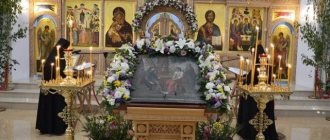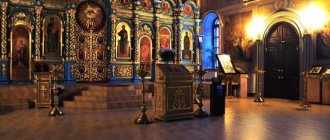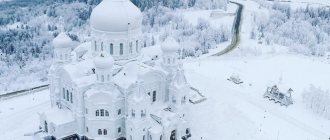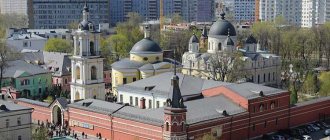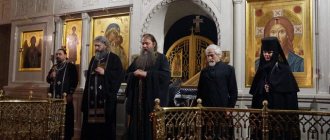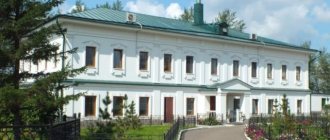Address: Volzhsky Prospekt, 1
The most famous Samara monastery, founded in the mid-19th century
, was once located on the city outskirts, and today it is a decoration of the historical center and is located at the intersection of the most popular tourist routes of Samara. Its bell tower and the heads of the temples are clearly visible from the observation deck of Pushkin Square, which closes Chapaev Square.
It is pleasant to walk around the monastery territory - it is well-groomed and planted with flowers. Today this active convent of the Samara-Togliatti diocese
- a prayerful and quiet place that tourists love to visit, and its creation began with a small spontaneously emerging
Orthodox
women's community
.
Description and location
The monastery is located on the left bank of the Volga. At first it stood almost on the shore, now the area is separated from the water by residential buildings.
Before the revolution, it was in charge of a huge territory, but with the advent of the USSR it was taken away and residential buildings were built on half of it.
It is important to know: the appearance of the monastery largely determined the view of Samara from the Volga side.
Externally, the monastery is very elegant: all buildings are made of red brick with white decorations and golden domes. There are many trees and flowers on the territory, and paths are laid out for convenience.
We bring to your attention an informative article about the Vyshensky Assumption Convent and St. Theophan the Recluse.
History of the monastery
The history of the convent in Samara began in the 16th century with the Transfiguration Monastery. Less than 30 people lived there and were supported by government funds. By order of Catherine II, the monastery was disbanded: the building was closed and the inhabitants were transported. This led to the appearance of “blueberry cell attendants” in the city: they were not nuns, but led a similar lifestyle.
In 1850 they petitioned to build a women's community. At that time, there were almost 40 people who wanted to devote themselves to God, and there were many sectarians in the city, which negatively affected the parishioners.
Construction began that same year, 5 years later Emperor Alexander II approved the monastery, and after another 5 years the community became a monastery. The terrible condition of the community at first (a small plot, cramped premises, a poor sacristy, a pillar with 4 bells instead of a belfry) gradually improved: thanks to donations from locals, the opening of a cemetery and permission to carry the Jerusalem icon from home, the monastery began to actively develop and settle down.
At the time of the revolution, there were several cathedrals and residential buildings, utility buildings, workshops, and a Sunday school on the territory. During the First World War, the monastery housed a hospital, and the sisters were engaged in sewing clothes for soldiers.
History of the Iversky Monastery (Samara)
Alexander II in mid-June 1860 approved the decision of the Holy Synod to transform the women's community in Samara into a monastery. This was followed by permission to tonsure twenty sisters and the abbess. One of them was of the clergy class, two were noblewomen, four represented the merchant class, two were peasant class, and the rest were bourgeois. The sisters' ages ranged from 40 to 60 years.
The monastic tonsure took place on August 21, and a week later, on August 28, the opening ceremony of the monastery took place, which was attended by representatives of the Samara clergy, city officials and numerous guests from among ordinary citizens. The abbess of the monastery became Maria Yanova, who in monasticism was named Margarita. She received the rank of abbess.
Fate during the revolution and in Soviet times
In 1919, the monastery was closed, but a community of believers was registered, which had the right to use the temples. A sewing artel was opened on the ground, residential buildings were given to workers, and valuables were taken away.
Interesting fact: the remaining nuns had to pay the same rent for housing as everyone else.
After 6 years, the artel was closed, and instead of the workers, employees of the State District Power Plant and a local brewery settled here. Due to their proximity to workplaces, they created a “worker town”. All churches were closed, some, including the cemetery, were destroyed or dismantled.
Monastery in the 20th century
By the beginning of the last century, the Iversky Convent was a large architectural ensemble that was constantly expanding. In 1901, a refectory church appeared on the territory of the monastery, although by that time there were already three churches, twenty-two residential buildings, a monastery school, abbess buildings and workshops on the territory.
Large areas were allocated for outbuildings: a kvass brewery, a laundry room, a prosphora room, two carriage houses, a bathhouse, three barns, three cellars, etc. In the monastery, much attention was paid to landscaping the territory: all free space was occupied by front gardens, flower beds, various shrubs .
Revival of the Iveron Monastery
It began in the 90s of the twentieth century with the official registration of the Iversky Monastery. Just 3 months later, all surviving buildings were transferred to the Orthodox Church.
After another 2 months, they were recognized as cultural monuments: the buildings were examples of the culture of the 19th century. The first service was held in 1992, and 2 years later Abbess Ioanna was appointed.
Temple of the Holy Spirit
This is important: at that time more than 10 nuns lived in the monastery.
At first, the monastery received back only a small part of the land, about 1/10 of the original. Later, the holdings expanded to half, but they could not give the second half to the authorities: residential buildings had already been built on these lands. Instead of these territories, the monastery was given a plot in the Volzhsky region - it was located 40 km from Samara. A temple of the Holy Spirit and a courtyard were built there.
See also: The amazing history of the Sanaksar Monastery in Mordovia
Abbess Antonina and her works
Since 1874, Abbess Antonina has become the abbess of the monastery, instead of Mother Margarita, who retired after twenty-five years of service. In former times, she served as the monastery treasurer. Like her predecessor, Mother Antonina made an invaluable contribution to organizing the life of the monastery. As a result of her efforts, in 1882 the construction of a warm stone church began in the name of the Tver Icon of the Mother of God. Six years later, the temple was solemnly consecrated, and regular services began to be held there.
But one of the main innovations, initiated by Abbess Antonina, was the construction of a spacious two-story hospital at the monastery. This project was realized thanks to the generous donations of the Samara merchant P. Shikhobalova, who transferred all the necessary funds to the Iversky Monastery (Samara). Two years later, in 1889, also through the efforts of the abbess, a parochial school was opened in the monastery, in which about a hundred girls from bourgeois and peasant families were constantly studying, and an orphanage for orphan girls was created under it.
Current state
Today there are several restored churches, a bell tower, 2 sisters’ buildings, a rector’s and a guest building, a refectory church, and a worship cross in memory of Cyril and Methodius.
Also, a necropolis was reopened on the territory, where eminent Samara residents were reburied, a monument to the public figure Alabin and the grave of Archpriest John Bukotkin were erected.
There are several workshops on the territory of the monastery:
- Zolotosveynaya: it was located here before the revolution and was revived after the 90s;
- Sewing: mainly vestments for priests, cassocks and clothes for the nuns themselves are sewn;
- Icon painting: the sisters do everything themselves, they also restore the icon;
- Publishing: this is a new but promising direction. A monthly newspaper, booklets, symbols and albums dedicated to the monastery are printed here.
At the beginning of the 21st century, 65 nuns live on the territory, including 10 nuns, 30 novices, 22 nuns and 3 schema-nuns.
Samara Banner
In 1876, according to the sketches of the artist N. E. Simakov, the nuns embroidered a banner. One side of the panel in the center was decorated with a gold embroidered Byzantine cross with the image of Cyril and Methodius, the other - the image of the Iveron Mother of God, also in a Byzantine cross.
With this banner, at the end of April 1877, Samarans saw off the militias who were going to Bulgaria to help liberate themselves from the Turkish yoke. Under this banner, in June 1877, the Bulgarian squad bravely fought near Stara Zagora. During the bloody battle, five standard bearers replaced each other. The broken but not defeated banner was taken from the battlefield, and immediately after the liberation of Bulgaria it took pride of place in the Sofia Museum of Russian-Bulgarian Friendship.
Interestingly, in 1981, the Bulgarians made an exact copy of this cloth and gave it to Samara.
Domains and Temples
Let's talk about everything in order.
Monastic territory
The monastery occupied quite a significant territory. It is surrounded by stone walls, at the corners of which there were 4 chapel towers. The entire land was divided by a passing road into two halves: the larger part was located on top of the hill, the smaller part in the lowland.
On the hillside there were 2 cemeteries, to which steps led. The area unoccupied by buildings was planted with trees and flowers. There was even a waterfall, thanks to which water was supplied to the establishments.
Take note: the area grew quietly thanks to the donations of neighboring plots by parishioners.
Also, the Iversky Monastery had more than a thousand acres of land, most of which was used for plowing. The remains were occupied by meadows, orchards, forests, and limestone mining sites. Basically, they were all rented out to local residents for the sake of making money.
Church of the Iveron Icon of the Mother of God
This is the first church built on the territory of the monastery - made of wood on a stone foundation with three domes. After 2 years, the northern aisle was completed, which was consecrated in honor of the icon of the Mother of God of Jerusalem.
It was placed under the Church of the Iveron Icon. The southern aisle was built with the money of public figure Alabin.
Interesting fact: the southern aisle was consecrated in honor of the martyr Varvara and Queen Helena, the patrons of his wife and deceased daughter.
At the very beginning of the 19th century, the dilapidated church was demolished, and the Jerusalem Temple was erected in its place.
Assumption Church
The second name is Sretensky. It was the second in time of construction and the first stone cold temple. It was built in the middle of the 19th century on the highest hill.
The construction itself went quickly, but the interior finishing took more than 10 years. Local merchants allocated money for the construction. The cathedral stood until its closure in 1929. The building was used as a garage for a whole year, and then it was blown up. A residential building was built instead.
Before the cathedral appeared in Samara, the Assumption Church was considered the most luxurious and majestic.
Bell tower
Its construction took 5 years. The original plan, drawn up back in 1856, was rejected because the price and height were too high, and construction did not begin until 20 years later. They agreed at a height of 64 meters.
Important : the appearance exactly copies the pre-revolutionary version.
However, with the advent of Soviet power, the bell tower was blown up at the same time as the Assumption Cathedral, and the bells themselves were taken away for melting down. The building reappeared in the monastery only in 2011, the bells were raised in 2012, the dome in 2013.
St. Nicholas Church
This is the gate temple, which was located on the middle tier of the bell tower. Dedicated to Nicholas the Wonderworker, funds for construction were allocated by staff captain Lobanov, who was being treated for tuberculosis in the city, and the Alasheyevs, who lost their son Nicholas.
See also: Valaam Monastery - an abode of the highest purity
From the latter they also received a family icon of the saint, an altar and other valuable religious objects. The amount of donations even exceeded the required amount.
Iversky Temple
It was built on the site of the church of the same name, when it became dilapidated and began to collapse in the 80s of the 19th century. Construction lasted 6 years and was financed by wealthy residents. During the USSR, the temple was converted into a club from, after some time a branch of “Samaraoblobubyt” was located in it. The cathedral was returned to the church in 1995.
Keep in mind : the abbot’s building adjoined the building from the north - both buildings were connected by a corridor.
The structure has a quadrangular shape and is painted peach on the outside. It has one large gilded dome, many windows and white decorations.
Temple-Chapel of the Royal Passion-Bearers
The second name is Royal Martyrs. This is a new building: construction began only in 2006. During excavations, the remains of a destroyed necropolis were found; after the work, some names were restored.
This is interesting: in the chapel, earth was walled up, brought from the supposed place of death of the royal family, and a memorial plaque was fixed on the wall.
It is a small single-domed building with a red dome and gold decorations. The walls themselves are white with red brick inserts.
Chapels
A chapel was erected on the banks of the Volga in 1850. It was a small room with several icons inside, its main task was to collect donations.
At first, the chapel did not generate income, but soon rumors spread among the parishioners that the icons on display had special divine powers. However, the leadership of the monastery did not confirm these rumors.
Several more chapels were installed in the city - at the Trinity Market (which stood for several years), near the railway station and next to the Strukovsky Garden. Many were demolished with the advent of Soviet power.
Monastery Cemetery
Initially there were two of them:
- "Upper" for clergy;
- “Lower” for ordinary citizens.
In the 20s, both cemeteries were closed; in the 30s, some were dismantled: the crypts were demolished, the ashes were “reburied,” and residential buildings were built on the land. The lower cemetery was used as a garbage dump, toilets were installed, and some crypts were used as cellars. During the Second World War, mines were made here. It happened that removed gravestones were refaced and used again.
Today, it is quite difficult to establish exact data about the burial: many documents have been lost. In the 90s, an entire massif was discovered, in which some of the unopened graves and monuments were preserved.
Monastery residents (abbots, sisters, clergy)
When the monastery opened, only 30 nuns wanted to live there, but after 2 years their number increased 4 times. The last census before the closure of the monastery in the 30s spoke of 440 persons. New faces were constantly added: these were female “volunteers”, their young relatives and orphans.
Important : all children were raised under the strict control and supervision of relatives or appointed guardians.
During the entire existence of the monastery, he had 5 abbess. Almost all of them came from families of priests, the first abbess was from the bourgeoisie. Today, management is in the hands of Abbess Joanna: she has been abbess since 1992. Among the most famous nuns are:
- Dorothea: one of the first to take monastic vows;
- Susanna: she received the nickname “Bee” for her hard work and desire to help. Collected donations;
- Nymphidora: baked prosphora for the Iveron Monastery and other cathedrals;
- Callista: was treasurer, in charge of the library and sacristy;
- Sofia: was treasurer.
The monastic parable at first consisted of a priest and a deacon, but their number was constantly changing - it increased and then decreased. The reason was unstable financial receipts: in the second half of the 19th century alone, more than 30 clergy were replaced.
Seizure of valuables
In the spring of 1922, the Samara provincial executive committee issued a decree according to which all valuables were confiscated from the monastery. These were precious vestments of the main icons of the monastery (Jerusalem and Iveron), a large ark, an altar cross, a silver chalice, ten icons, silver lamps and many other valuable and holy things for the monastery.
In 1925, the sewing artel also ceased its activities; the residential buildings were occupied by workers of the Samara State District Power Plant and the Zhigulevsky Brewery, who were located nearby. Thus, the city leadership formed a “workers’ town.” In the same year, the Iversky Temple was closed, and a year later the wooden chapel of the Jerusalem Temple was dismantled.
The same fate befell the other three churches of the monastery, but this happened in 1929. In 1930, the fence and bell tower were dismantled, most of the outbuildings were destroyed and the monastery cemetery was actually destroyed. Miraculously, the grave of Peter Alabin survived, and in 1987 it was declared a historical monument. The remaining buildings were transferred to various organizations.
Monastic way of life
The life of the nuns was not very diverse: the main task was prayer. It was divided into church or general and home: nuns along with icons were invited to perform the ceremony in homes.
See also: Church of St. Nicholas the Pleasant in Khamovniki: the history of an Orthodox shrine of the 17th century
Women also carried out obediences: they read the psalter, prepared food and prosphora, did needlework (sewing, icon painting), taught at school, looked after the sick, and sang in the choir. In addition to generally useful tasks, women worked “for themselves”: clothes, light and heat were paid out of their own pockets.
This is interesting: local nuns embroidered the Samara banner, which was transferred to the Bulgarians in the Russian-Turkish War.
Today's life is practically no different from that described above. The only exception is the need to conduct excursions and receive pilgrims.
Saints and shrines
Among the shrines of the monastery, the following stand out:
- Iveron Icon of the Mother of God: the family icon was given by the merchant Marikhina with the condition that the monastery would receive her “name”.
- Our Lady of Jerusalem: this is one of the most significant icons. People came to worship her, and on holiday they brought her into their homes. Considered miraculous. It is believed that the first abbess compiled a list of miracles performed through prayers before this icon, but the records were lost.
- Several icons with holy relics - Chernigov saints, St. Tikhon of Zadonsk, Blessed Matrona of Moscow;
- Particles of holy relics, including the relics of John the Baptist, Apostle Andrew, Mary Magdalene and others.
Last years before the revolution
Abbess Antonina went to the Lord in 1892 and was buried in the Church of the Tver Icon of the Mother of God, to the construction of which she put so much mental and physical strength. Her place was taken by the nun Feofania, who had previously served as treasurer, just like her, but six years later she was removed from this position and gave way to the priestly widow A.V. Milovidova, who took the name of Seraphim in monasticism. Over the next years, she led the monastery, skillfully combining spiritual and economic activities. Under her leadership, the Iversky Monastery (Samara) faced the dramatic events of 1917.
It should be noted that by this period the monastery had achieved a lot in its development. There were four temples on its territory. Services in the Iversky Monastery (Samara) were attended by both the nuns of the monastery and the residents of the city. In addition, the monastery was famous for its well-maintained charitable institutions, among which were: a hospital, a parochial school, a shelter for orphan girls and a hospice. The total number of inhabitants of the monastery in 1917 exceeded four hundred people.
Information for pilgrims and tourists
How to get there
It is important to know that there is more than one monastery in Samara, and if you ask: “How to get to the monastery?” - you can be sent to the “monastery on Cheremshanskaya”. “Cheremshanskaya” is a street in Samara and a public transport stop of the same name. There really is a monastery there, but another one is the Holy Resurrection Monastery.
The Iversky Convent is located at Volzhsky Prospekt, building 1. The nearest metro station is Alabinskaya. From it you will have to walk 2.8 km, or you can take bus 61 or minibus 247 or 261 from the stop “Ul. Osipenko" to the stop "Iversky Monastery".
You can get from Moscow to Samara:
- By plane: regular flights depart from all 3 airports in the capital.
- By train: departure from Kazansky railway station.
You can get there from St. Petersburg:
- By plane: departure from Pulkovo.
- By train: flights depart from Moskovsky Station.
Contacts
Official website: https://iverskiy.rf; Email address; Phone, 37-14.
Schedule of services and patronal holidays
You can find out the current schedule by following the link. Weekly services are held at: 1. 6:00 - Midnight Office; 2. 6:30 – 3 canons and Akathist of the day; 3. 7:30 – Third and Sixth hours; 4. 8:00 – Liturgy; 5. 16:40 – Ninth hour; 6. 17:00 – Vespers, Compline, Matins.
Sundays and holidays are slightly different:
1. 7:00 – Midnight Office; 2. 7:30 – Canon to the Guardian Angel; 3. 7:45 (Sunday) – Paraklis; 4. 8:40 - Third and Sixth hours; 5. 9:00 – Litugy; 6. 16625 – Ninth hour of Compline; 7. 17:00 – All-night vigil.
The most significant holidays are:
- Celebration in honor of the Iveron Icon: February 25 - entry into the Valdai Monastery, October 26 - meeting in Moscow, Tuesday of Bright Week - appearance to monks.
- Celebration in honor of the righteous Alexander Chagrinsky: January 4 - performance, October 15 - glorification, June 22 - finding of relics.
- Celebration of St. Nicholas the Wonderworker: December 19 - the main holiday, May 22 - the discovery of relics.
- Celebration of the Jerusalem Icon of the Mother of God: October 25.
- Celebration of the Holy Royal Passion-Bearers: July 17.
The Iversky Convent is still active: despite its closure during the Soviet era, it has been restored and welcomes guests. Today, several dozen nuns live in it, cathedrals have been restored and crafts have been established.
For more information about the Samara Iversky Monastery, watch the following video:
Creation of a women's community
The founding date of the monastery is considered to be 1850, when a chapel was built in which all-night vigils were held. To send them, the parables of two churches that then existed in the city were used - the Kazan Cathedral and the Trinity Church. Over time, eight cells were built around the chapel, in which those who wanted to devote their lives to serving God settled.
From these first nuns, a small community was formed in 1852, for the care of which a priest was appointed. The pious maiden Maria Yanova became her abbess. This choice was very successful, since she subsequently proved herself to be an energetic and talented organizer. Thanks to her work, an intensive process of community development began.

